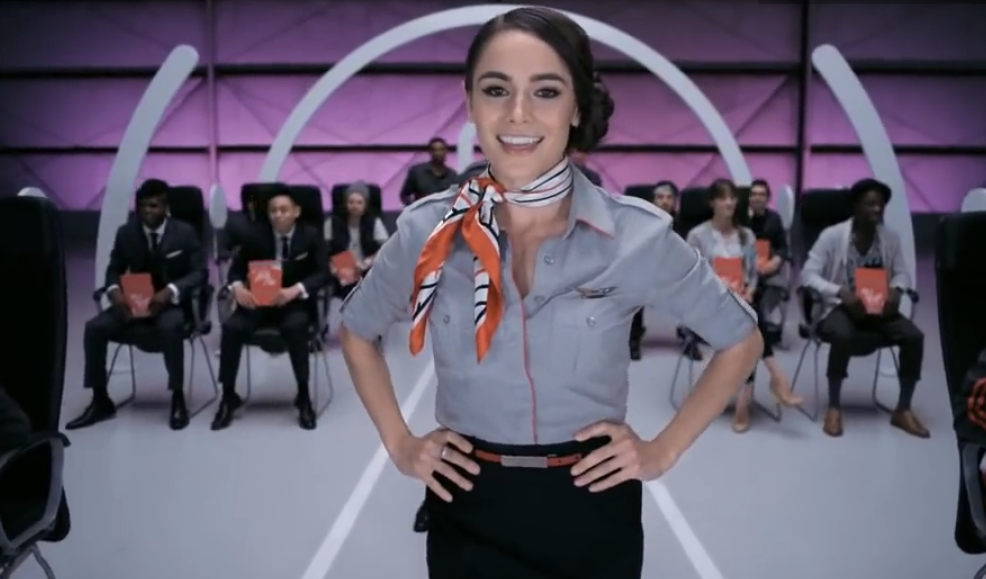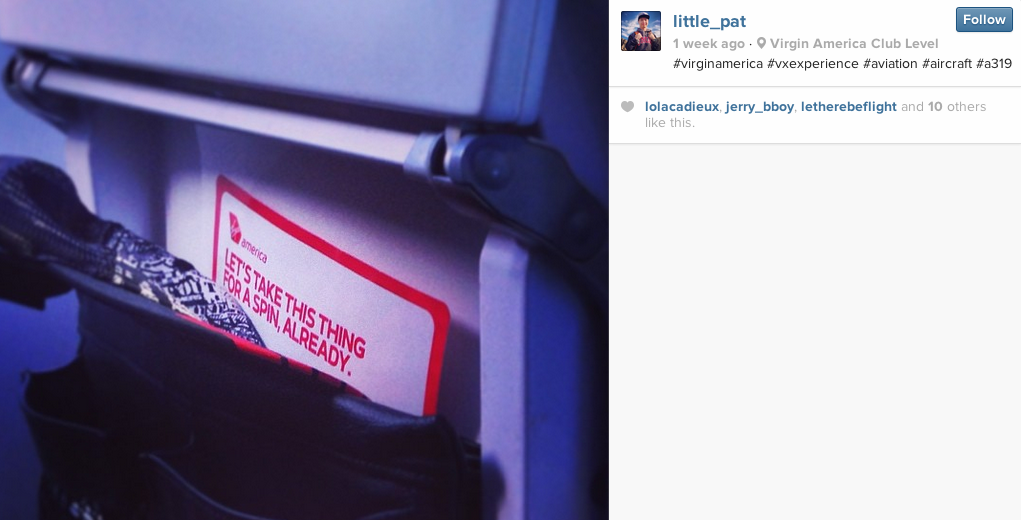
Several airlines have recently debuted new, creative in-flight videos. But none have gone quite as viral as Virgin America’s “Virgin America Safety Video #VXsafetydance,” which has racked up more than 9 million views on YouTube since its release last fall. The video is a five-minute dance routine in an airplane hangar with lyrics that explain all the essential airline safety habits for fliers.
“We were a little nervous when we launched it because people loved the old video so much,” said Abby Lunardini, the vp of marketing and communications at Virgin America. But the original ground-breaking animated safety video had begun to feel a little stale. “Six years after we had done the first one, we wanted to come up with something entirely different and fresh.”
The idea for a new dance-themed safety demo originated with Virgin America’s small marketing team — social media manager Jill Fletcher, Lunardini, an assistant, and its creative director, Jesse McMillin. For the video, Virgin America worked with another arm of the Virgin empire, Virgin Produced, with a budget, according to Lunardini, one-twentieth the size of its competitors, to create the five-minute clip.
But, for the team, the real challenge quickly centered around how to keep engagement going around a one-off video. The solution: a call for submissions from fans.
“When we were formulating the social media piece of the new video, we wanted to include people within the actual safety video,” said Lunardini. “We did a digital and social campaign around the video and are going to do a next version. People are submitting their dance auditions through social to us, and they’re hilarious.”
Once the videos were submitted, judges, like the video’s director John M. Chu, and “Footloose” choreographer Jamal Sims, went through the user submissions and selected a winner, who will be a dancer on future versions of the safety video. The entire campaign received 7,000 tweets to the hashtag #vxsafetydance, and 364 contest entries through Instagram, according to Webstagram.
For the airline, driving social interaction with a small budget is key. Another ongoing social initiative led by the airline, #vxexperience, encourages travelers to share how their Virgin America flight went across social platforms.
Ad position: web_incontent_pos1
“A lot of airlines probably wouldn’t want people to post their airline experiences online,” said Lunardini. “We were surprised how much feedback we get.” Virgin also has an interactive website to tout in-flight features and display Twitter and Instagram shout-outs from passengers’ experiences via the #vxexperience hashtag.
On social, the brand has more than 507,000 Twitter followers, 521,000 likes on Facebook, and more than 33,000 on Instagram. (By comparison, Delta Airlines has 632,000 followers on Twitter, and American has 763,000.)
Ad position: web_incontent_pos2
“Because we have a smaller budget and being a little scrappier and doing something differently to drive awareness,” said Lunardini. (Virgin reported a third quarter net income of $33.5 million in November 2013. By contrast, competitor American Airlines reported a profit of $530 million.)
“The safety video obviously had a life of its own online,” added Lunardini. “So how does the brand extend beyond the cabin beyond?'” One dance move at a time, apparently.
More in Marketing

In the marketing world, anime is following in the footsteps of gaming
As marketers look to take advantage of anime’s entry into the zeitgeist, they might be wise to observe the parallels between the evolution of anime as a marketing channel and the ways brands have learned to better leverage gaming in recent years.

With the introduction of video ads and e-commerce, Roblox looks to attain platform status
Roblox is expanding into more areas than just ads in 2024. Much like platforms such as Amazon and Facebook have transcended their origins to evolve from their origins as online marketplaces and social media channels, Roblox is in the midst of a transformation into a platform for all elements of users’ virtual lives.

PepsiCo wants to remain a ‘driver of culture’ as it turns to influencers and activations amid rebrand
The soda-maker says it can translate cultural relevance into sales volume.
Ad position: web_bfu
